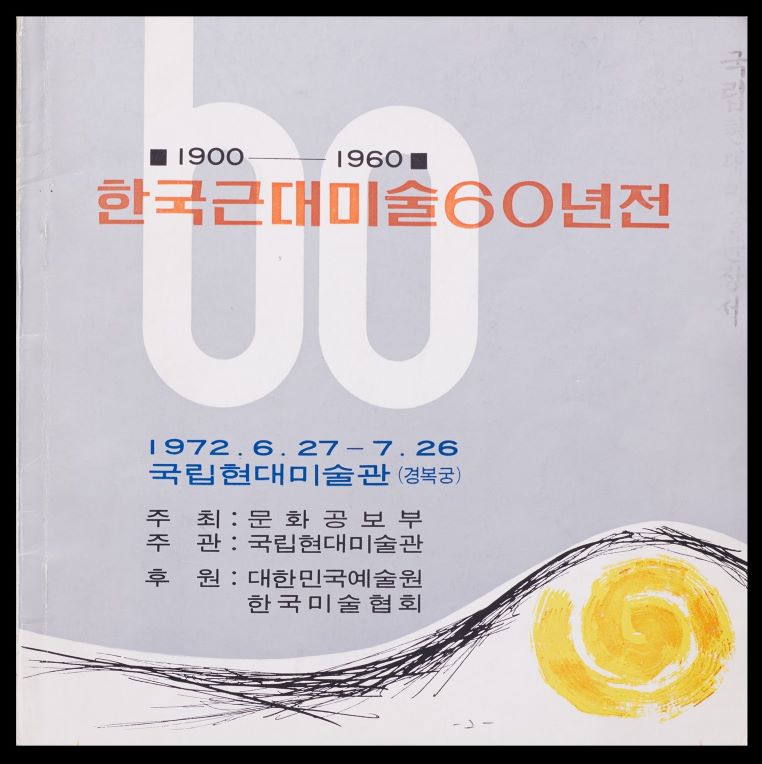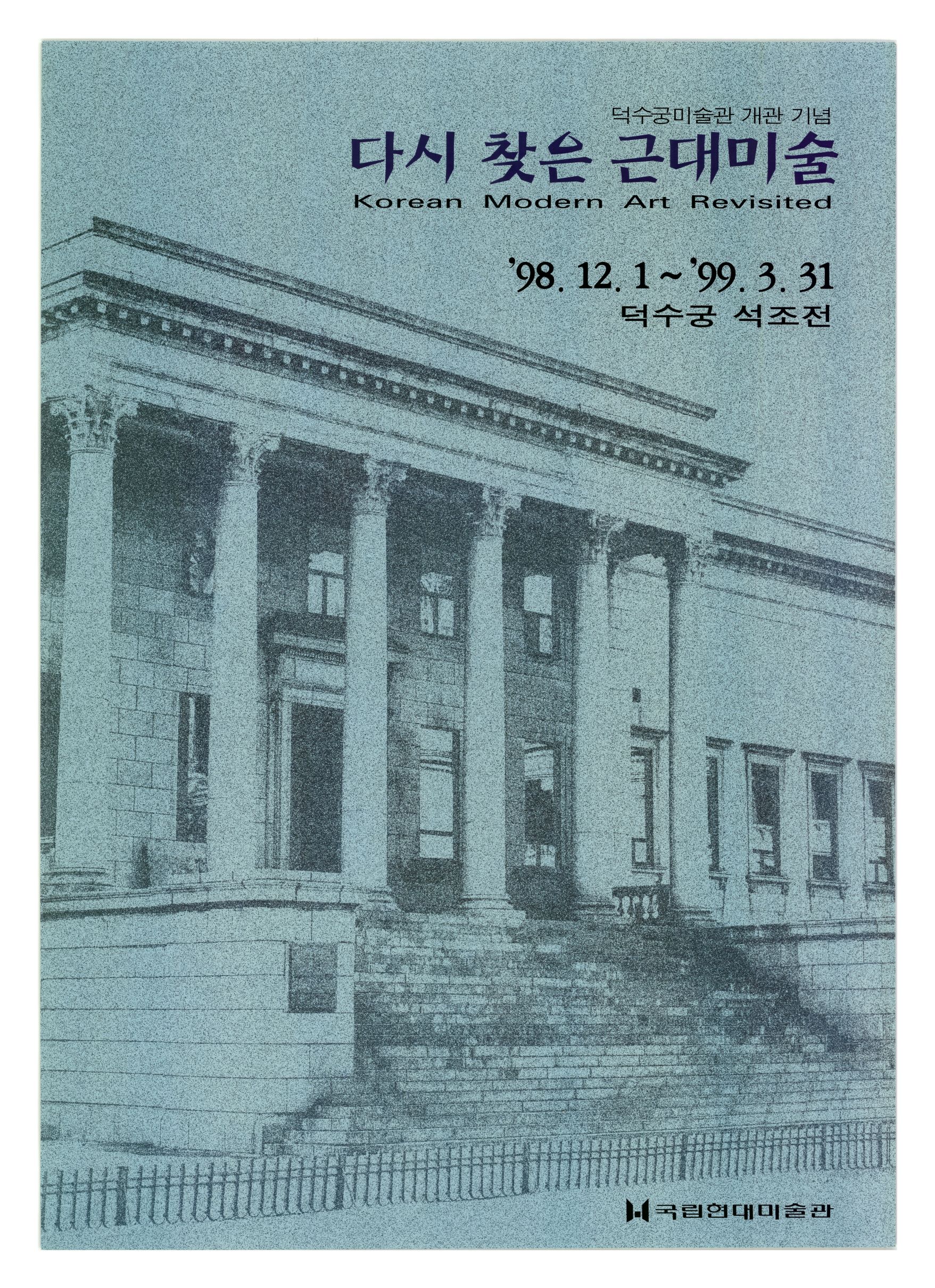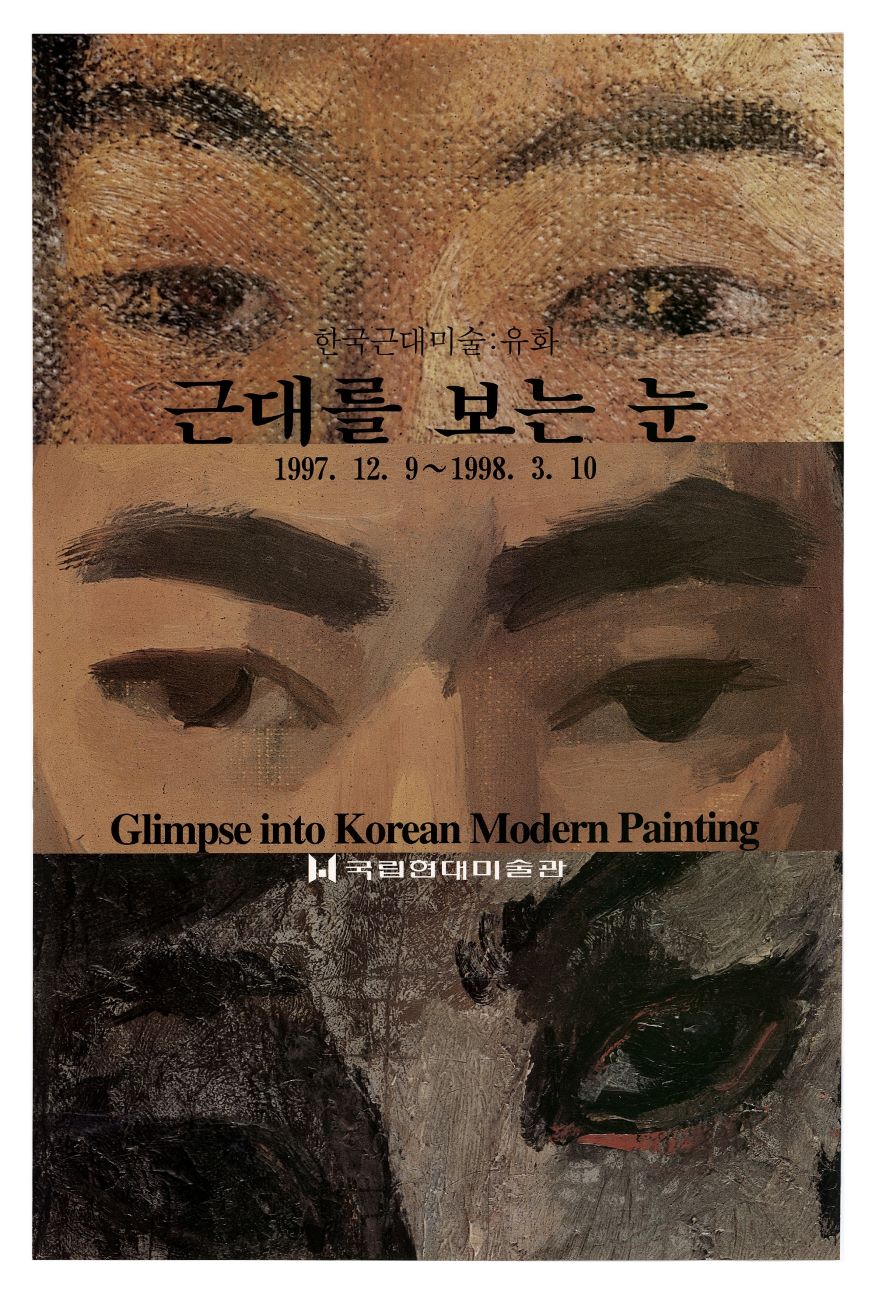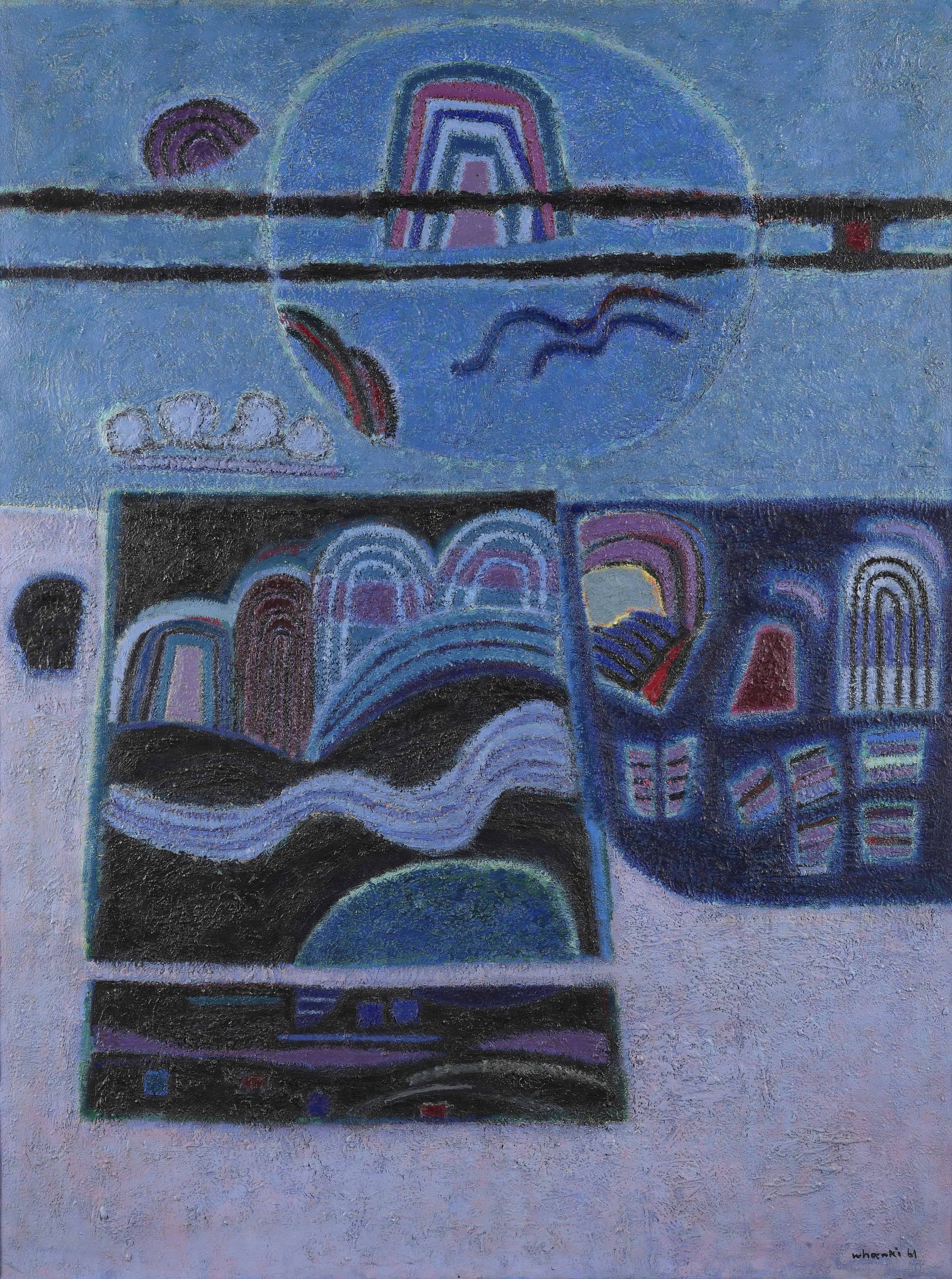
60 Years of Modern Korean Art, Brochure, 1972, MMCA Art Research Center Collection
60 Years of Modern Korean Art
* Source: Multilingual Glossary of Korean Art. Korea Arts Management Service
Related
-

Korean Modern Art Revisited
Korean Modern Art Revisited was a special exhibition held by the National Museum of Contemporary Art (now MMCA) in Seokjojeon Hall at Deoksugung Palace from December 1 in 1998 through March 31 in the following year to coincide with the opening of the MMCA’s Deoksugung branch. As the MMCA was relocated to a new museum built in Gwacheon in 1986, the Western Building of the Deoksugung Palace, which had been used as the Bureau of Cultural Heritage Management, was reopened in 1998 as the Deoksugung Palace branch of the MMCA. The MMCA declared that its Deoksugung Palace branch would be operated as an art museum specializing in exhibitions and research on modern Korean art. The Deoksugung Palace branch held the inaugural exhibition Korean Modern Art Revisited with the intention of bridging the gap between Korean modern and contemporary art. There were 146 works on display, including forty-nine works by twenty-six ink-and-wash and polychrome painters, eighty-three works by forty-three oil painters, and fourteen works by six overseas Korean artists. In line with its intention to restore the lost history of modern Korean art, the exhibition unveiled for the first time the works by artists who defected to North Korea and had been excluded from Korean art history, including Lee Yeoseong, Pai Unsoung, Chung Chong-you, Gil Jinseop, and Lee Qoede. It also displayed works by artists active in Central Asia, Japan, and other foreign countries, such as Shin Sunnam (Nikolai sergeevich Shin), Park Seongyong (Nikolai Park), Cho Yanggyu, and Chun Huahuan. Moreover, it unearthed and exhibited works by artists who had not been spotlighted in South Korea, including Jin Hwan, Park Myungjoe, Kim Seyong, and Choi Keunbae. This exhibition was the first to highlight the MMCA’s role in reconstructing modern art history by discovering and exhibiting lost or forgotten modern artworks. Until the opening of its Seoul branch in Sogyeok-dong in 2013, the MMCA maintained a dual system. The main building in Gwacheon focuses on contemporary art while the Deoksugung Palace branch emphasizes modern art.
-

100 years of Korean art
100 Years of Korean Art was a special exhibition held at the National Museum of Contemporary Art, Korea (now MMCA) to commemorate the sixtieth anniversary of Korea's independence. It offered an overview of Korean art from 1905 to 2005 in two parts. Art historian Kim Hyunsook orchestrated the entire project. Part 1, which covered art from 1905 to 1959, was held from August 13 to October 23 in 2005, and Part 2, which oversaw art from 1960 to 2005, was held from June 2 to September 10, 2006. Part I of the exhibition was segmented into six periods as follows: “Prehistory—Towards Modernity: 1876-1905,” “Between Enlightenment and the Anti-Japanese Movement: 1905–1919,” which oversaw visual art during the anti-Japanese and patriotic movements as well as contemporaneous Korean art as seen by foreigners; “The Bright and Dark Sides of the New Culture: 1919–1937” focusing on the art that evolved by accepting new cultural trends and was directed toward autonomous modernity; “From Modernism to Imperial Citizens: 1937–1945” covering avant-garde art to pro-Japanese art; “Liberation and Division: 1945–1953” focusing on art created after liberation from Japan under the US military government, and during the Korean War; and “The Shadow of the Cold War: 1953–1960.” Part 2 of the exhibition was divided into four themes and periods: “1957–1966: Invitational Exhibition of Contemporary Artists” showing the proliferation of the new post-war art form, Art Informel, under the subtitle “Tradition, Humanity, Art, Reality”; “1967–1979: Young Artists' Union Exhibition," focusing on experimental art; “1980–1987: 5.18 Gwangju Democratization Movement,” displaying socially engaged art and folk art; and “1988–Present: Seoul Olympics,” overseeing the post-modernist and globalization trends in the late 1980s. As 2006 marked the 20th anniversary of the relocation of the National Museum of Contemporary Art, Korea from Deoksugung Palace to Gwacheon, the academic events that were part of the first and second exhibitions of 100 Years of Korean Art were posted online and named the "20th Anniversary of the Relocation to Gwacheon Online Exhibition." 100 Years of Korean Art was a new kind of exhibition that attempted to include not only fine art, but also visual culture in general, including painting, sculpture, calligraphy, crafts, design, advertising, photography, film, and architecture, as well as archives, in Gallery 1, 2, and 7 and the central hall of the National Museum of Contemporary Art, Korea Gwacheon. It was also an attempt to show 100 years of Korean art as an integrated product formed in political, social, and cultural contexts. The exhibition catalogue for Part I was published in 2006 as a 707-page book by Hansgilsa Publishing Co. with the participation of Kim Yoon-Soo and fifty-seven other contributors. The exhibition catalogue for Part 2 was published in 2006 as a 45-page book by the National Museum of Contemporary Art, Korea.
-

Glimpse into Korean Modern
Glimpse into Korean Modern was an influential exhibition series on Korean modern art. It began with an oil painting exhibition at the National Museum of Contemporary Art, Korea (now MMCA) in December 1997 and sequentially proceeded to various fields such as ink wash painting, sculpture, architecture, and crafts. An oil painting exhibition was held from December 9, 1997 to March 10, 1998, a sculpture exhibition was held from August 24, 1999 to October 31, 1998, and a craft exhibition was held from November 16, 1999 to January 30, 2000. The exhibition was designed to establish an national art history by re-evaluating and understanding Korean modern art. Reflecting the research achievements of Korean modern art, the exhibition attempted to excavate and organize artwork and materials that were lost amid a rapidly changing society and played a role in suggesting various in-depth research directions. The exhibition, organized field by field, focused on newly discovered works beyond one common perspective.
Find More
-

Lee Jungseop
Lee Jungseop (1916-1956, pen name Daehyang) was born in Pyongyang. He learned oil painting from Yim, Gilbert Pha at Osan School, Jeongju. He attended the Teikoku Art School in Japan in 1936 and moved to the Bunka Gakuen to learn oil painting in 1937. During his school years, he submitted his work to Japan Free Artists Association [Jiyū bijutsuka kyōkai] in 1938 and to the New Artists’ Association [Sin misulga hyeophoe] Exhibition. After his return to Korea in 1943, he was active in Wonsan and moved to South Korea with his family after the outbreak of the Korean War. He sought shelter in Busan and Seogwipo but had to send his Japanese wife and two sons back to Japan in June 1952 due to financial difficulties. He submitted work as a war correspondent painter. He orchestrated solo exhibitions in Tongyeong in 1953 and Midopa art gallery in Seoul and for the United States Information Service Center at Daegu in 1955. He died at a Red Cross hospital in 1956 after suffering from malnutrition and liver cirrhosis. His works, such as White Ox, illustrated local subject matter and family life with a simple touch, and one of his drawings on silver foil was purchased by the Museum of Modern Art in New York. A high-profile posthumous exhibition in 1972 at Hyundai Hwarang greatly increased the popularity of his work among the general public.
-

Kim Whanki
Kim Whanki (1913-1974, pen name Suhwa) was born in Sinan, Jeollanamdo, and his family origin was from Gimhae. He studied at the Department of Fine Arts at Nihon University, Tokyo, Japan from 1933 to 1936. He joined the Avant-Garde Western Art Institute in 1934 and submitted his work to Avant-Garde art associations, such as the Second Division Exhibition Nikaten (Nika Art Exhibition) and the Exhibition of the Free Artists Association (Jiyu Bijutsuka Kyokai). After independence, he organized the New Realism Group and worked as a professor in the Department of Fine Art at Seoul National University (1946-1950) and Hongik University (1952-55). He lived in Paris from 1956 to 1959, and after his return, he became a professor and later the Dean of the Fine Art College at Hongik University (1959-1963). He participated in the seventh Sao Paulo Biennale and won an honorary award, and then moved to New York. He abruptly passed away while having a solo exhibition at Poindexter Gallery, New York, ironically when his career in the US was at its peak. As a pioneer of Korean abstract art, he started by working in geometric abstraction and moved on to semi-abstract work that featured natural motifs such as the mountain, the moon, and the river. After moving to the U.S., he returned to abstraction with his so-called "dot paintings." His painting 16-Ⅳ-70 #166 Where, in What Form, Shall We Meet Again? (1970), was awarded a grand prize at the Korean Art Grand Award Exhibition and has inspired many contemporary Korean artists. His work Rondo (1938) was selected as No. 535 within the national Registered Cultural Properties.
-

Gu Bonung
Gu Bonung (1906-1953, pen name Seosan) was born in Seoul. He started his education in drawing at Gyeongsin Highschool. He learned sculpture from Kim Bokjin of Goryeo Art Studio [Goryeo misulwon] and then won an award for Self-Portrait at the Sixth Joseon Art Exhibition [Joseon misul jeollamhoe] in 1927. He attended Kawabata University Painting School in 1928 and studied at the Department of Aesthetics at Nihon University before graduating from the Taiheiyo Art School in 1933. He was selected for the Nikakai art exhibition in 1930. After returning to Korea, he participated in minor artists groups and non-govermental art associations, such as Mogilhoe Association and the White Savages Group [Baekmanhoe], instead of applying to the Joseon Art Exhibition. In his essay “Theory: War and Artist” (Maeil Sinbo, 1940.7.9.), he was accused of a Pro-Japanese bias after he encouraged artists to serve the Japanese empire. Immediately after independence, he worked as an editor of fine art in the Ministry of Culture and Education of the U.S. Army Military Government in Korea (USAMGIK) in Korea and was a part-time employee of the Seoul Sinmunsa Newspaper Press in 1949. His paintings illustrated a powerful decadent style based on a dissenting spirit and Fauvist Expressionism. In the mid-1930s, he began focusing on Oriental style oil painting.






